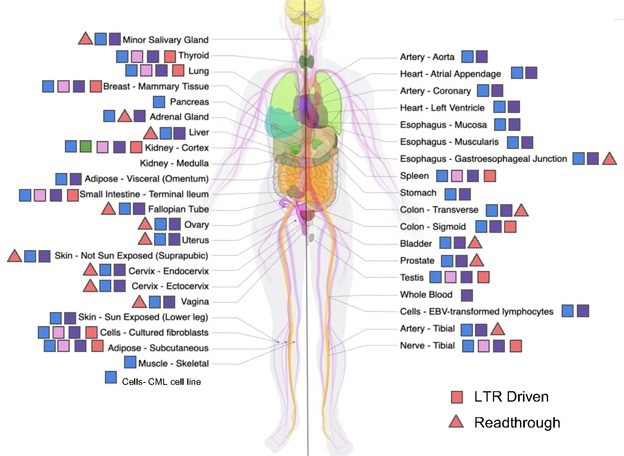Ancient viral remnants in the human genome are active in both healthy and diseased tissues, restricting their applicability as disease indicators, according to a study published on October 18th, 2022, in the open access journal PLOS Biology by Aidan Burn at Tufts University in Boston, USA and colleagues.
 HML-2 ORF Transcripts in the Human Body: This map of the human body (adapted from the GTEx consortium website with permission) displays the possible expressed Human endogenous proviral HML-2 ORFs in each tissue sampled. Blue shapes represent Gag, green represent Pro, pink represent Env and orange/purple represent Rec and Np9 respectively. A square indicates expression due to read through transcription from an adjacent or surrounding gene or otherwise undetermined. A triangle demonstrates LTR driven transcription of viral ORF shown. This map displays the wide range of HML-2 viral ORFs that could be transcribed throughout the body in non-diseased tissue. Image Credit: Burn A., et al., 2022, PLOS Biology, CC-BY 4.0.
HML-2 ORF Transcripts in the Human Body: This map of the human body (adapted from the GTEx consortium website with permission) displays the possible expressed Human endogenous proviral HML-2 ORFs in each tissue sampled. Blue shapes represent Gag, green represent Pro, pink represent Env and orange/purple represent Rec and Np9 respectively. A square indicates expression due to read through transcription from an adjacent or surrounding gene or otherwise undetermined. A triangle demonstrates LTR driven transcription of viral ORF shown. This map displays the wide range of HML-2 viral ORFs that could be transcribed throughout the body in non-diseased tissue. Image Credit: Burn A., et al., 2022, PLOS Biology, CC-BY 4.0.
Viral infection of sperm or egg cells can lead to viral genes becoming irreversibly integrated into the host genome, and the genetic relics of ancient viruses, referred to as endogenous retroviruses (HERV), account for around 8% of the human genome. While no longer infectious, certain HERVs still have intact genes, and HERV RNA transcripts in human cells have been associated with some malignancies.
But HERV expression in healthy tissues has largely gone unstudied. To fill this information gap, researchers examined the presence of transcripts from a recent HERV subgroup, HML-2, in non-diseased tissues using RNA sequence data from the Genotype Tissue and Expression project.
This collection contains gene expression data from 54 various types of tissues gathered from almost 1000 people. HML-2 transcripts were found in all tissue types, with higher amounts in the cerebellum, pituitary, testis, and thyroid.
The findings show that HML-2 activity is not just present in malignant or diseased tissues, which has significant clinical repercussions. For instance, background expression in healthy tissues would need to be taken into consideration when using HML-2 expression as a cancer biomarker or therapeutic target.
The researchers state that the expression levels of more ancient HML-2 viruses were highest in human tissues, suggesting that cells may suppress the activity of younger, less-degraded HERV fragments that include entire protein-coding sequences to avoid the synthesis of dangerous viral proteins.
We have found that nearly all normal human tissues express, in their RNA, one or another of about three dozen endogenous proviruses, remnants of widespread retrovirus infection of our distant ancestors. We expect this finding to provide a basis for further studies to understand the role of these elements in human biology and disease.”
John Coffin, Study Senior Author, Tufts University
Source:
Journal reference:
Burn, A., et al. (2022) Widespread expression of the ancient HERV-K (HML-2) provirus group in normal human tissues. PLOS Biology. doi.org/10.1371/journal.pbio.3001826.